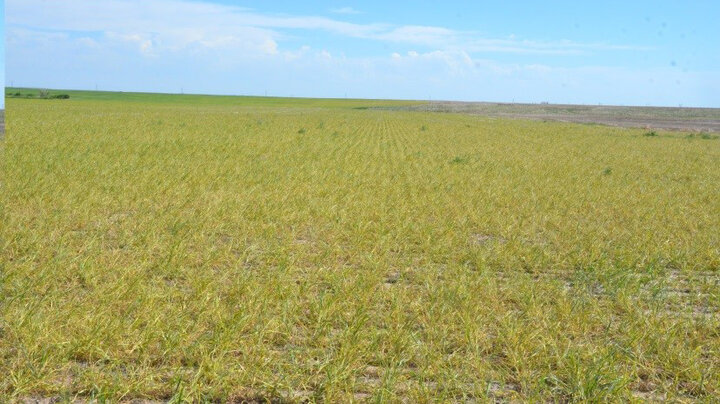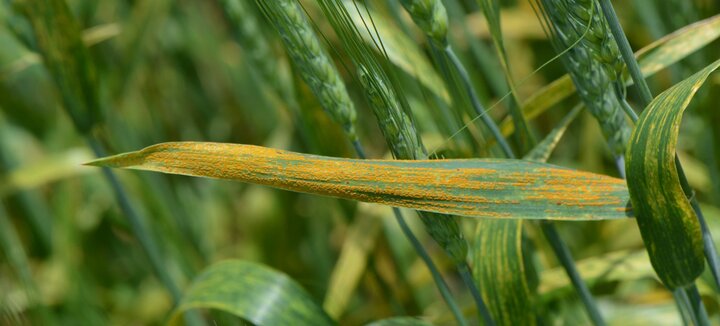Because of the widespread occurrence and severe epidemics of wheat streak mosaic and stripe rust in Nebraska in 2017 and 2015-2017, respectively, this wheat disease update is devoted to these two diseases.
Wheat Streak Mosaic
Wheat streak mosaic is a disease caused by wheat streak mosaic virus (WSMV). Wheat fields were affected throughout the state in 2017. However, the most severely impacted part of the state was the southern Panhandle where severe symptoms developed (Figure 1) and total loss occurred in some fields.
WSMV is transmitted by wheat curl mites (WCMs) which also transmit two other viruses: High Plains wheat mosaic virus (HPWMoV) and Triticum mosaic virus (TriMV). WSMV is the most predominant and widespread. Research conducted at the University of Nebraska-Lincoln has shown that TriMV often occurs together with WSMV and all three viruses can also occur together. When two or all of the three viruses occur in the same crop, symptoms are more intense and yield loss is much higher than in the presence of one virus.

WSMV Risk Factors
- The highest risk is volunteer wheat that emerges in wheat fields just before harvest following a hail storm. The hail shatters grain that is mature enough to germinate. Following germination, WCMs move from the maturing wheat crop to the young volunteer and both the mites and virus multiply on it throughout the summer. Volunteer wheat in summer crops such as sunflower also adds to the risk of WSMV.
- Crops or grassy weeds that are hosts of WCMs or WSMV also pose a risk if they are allowed to grow past fall wheat emergence. Crops other than wheat that are hosts of WCMs or WSMV include corn, rye, oats, barley, sorghum, and foxtail millet. Grassy weeds that are hosts include jointed goatgrass, downy brome, sandbur, crabgrass, barnyardgrass, stinkgrass, witchgrass, and green foxtail.
- A cool, wet summer favors growth of volunteer wheat and other hosts of WCMs or WSMV, as well as survival and reproduction of WCMs. It also prolongs the period of growth of summer crops that are hosts of WCMs or WSMV, resulting in the overlap of these crops with fall planting of wheat.
- A prolonged fall with above normal temperatures as in 2016. During such a fall, WCMs as well as WSMV remain active, reproduce, and spread for a longer time and at higher levels compared to a normal fall, causing severe damage to the wheat crop. This damage is exacerbated if a warm fall is followed by a mild winter.
- Early planting of wheat poses a significant WSMV risk. It allows more time for mites to infest wheat, multiply on it, and transmit WSMV to it, as well as more time for WSMV to multiply within the wheat crop during favorable warmer temperatures.
Management of WSMV
- Controlling volunteer wheat, especially pre-harvest volunteer that emerged in wheat fields or summer crops, is critical. Post-harvest volunteer should also be controlled. Volunteer wheat should be completely dead at least two weeks before fall planting.
- Control grassy weeds in and close to fields to which wheat will be planted in the fall.
- Avoid planting wheat too early. Instead, plant at the recommended date for your area.
- Avoid planting wheat next to late maturing summer crops that are hosts to WCMs or WSMV, such as corn, foxtail millet, sorghum, or small grain cover crops.
- Plant wheat varieties with greater resistance or tolerance to WSMV that are adapted to your area or region. Although most varieties grown in Nebraska are susceptible, a few have good resistance or tolerance.
- Plant high risk fields last; these are fields adjacent to grassy weeds and late maturing host crops such as corn.
Stripe Rust
Stripe rust is caused by the fungus Puccinia striiformis f. sp. tritici. It has become increasingly common in the south central and central Great Plains. The most recent major epidemics of the disease in Nebraska occurred in 2010 and 2015 (Figure 2).Varying levels of severity and prevalence have occurred almost yearly since 2010. Yield loss due to stripe rust can be as high 40% or greater.
Stripe Rust Risk Factors
- A high inoculum load in early spring in southern states where the wheat rust pathogens overwinter.
- A prolonged warm fall followed by a mild winter. These conditions favor fall infections as occurred in the fall of 2016 and elevate the risk of stripe rust overwintering in Nebraska.
- Grassy weed hosts and volunteer wheat enable stripe rust to survive well past wheat harvest, thereby providing inoculum for fall infections.
- Because stripe rust is favored by cool temperatures, a cool, wet spring is ideal for infections and disease spread within and between wheat fields.

Management of Stripe Rust
- Plant resistant varieties that are adapted to your area.
- Avoid planting wheat too early in the fall as doing so favors fall infections which if severe can damage the wheat crop and elevate the risk of overwintering.
- Scout wheat fields starting early in the spring for early detection which will enable you to take timely management measures to prevent disease development and spread within your field.
- Monitor stripe rust reports in states south of Nebraska to help you prepare for it.
- Apply a fungicide. In a high risk situation (stripe rust detected early in the spring and a wet, cool spring), two sprays may be needed, one in early spring and a second one to protect the flag leaf. Do not spray for stripe rust in the fall except in the very rare situation where infections are very severe. Even then, consult an extension specialist for a recommendation.

